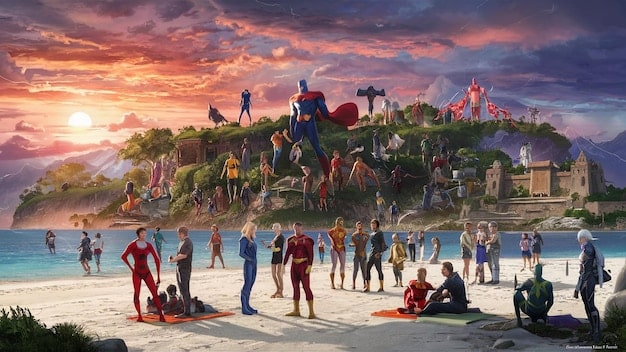Explore the Highest-Grossing Movie Franchises: Is Your Favorite Ranked?

Through meticulous analysis of box office data, this article unveils the top five highest-grossing movie franchises of all time, offering insights into their enduring appeal and global financial impact in the entertainment industry.
Ever wondered which cinematic sagas have truly dominated the global box office? In the ever-evolving landscape of film, certain franchises transcend mere entertainment to become cultural phenomenons, raking in billions and captivating generations. Join us as we explore the financial giants of Hollywood, in “Unveiled: The Top 5 Highest-Grossing Movie Franchises of All Time – Where Does Your Favorite Rank?”
The Enduring Power of Cinematic Universes
The concept of a cinematic universe, where interconnected stories and characters weave together across multiple films, has become the uncontested titan of modern Hollywood. This strategic approach allows studios to build immense long-term value, fostering deep audience engagement and creating a loyal fanbase ready to invest in the next installment.
Unlike standalone films, these expansive narratives offer a continuous journey, providing a sense of comfort and familiarity that encourages repeat viewings and merchandise purchases. The success lies not just in the individual films but in the cumulative emotional investment audiences make over years, sometimes even decades.
Building Blockbusters: More Than Just Movies
A successful cinematic universe is meticulously planned, often years in advance, with an overarching narrative that allows for individual character arcs and spin-offs. This foresight enables studios to leverage cross-promotional opportunities and maintain a consistent brand identity.
- Story Cohesion: A strong narrative backbone ensures continuity and prevents plot holes, keeping the audience immersed.
- Character Development: Audiences connect deeply with characters who evolve and face new challenges across multiple films.
- Fan Engagement: Active fan communities, theories, and discussions contribute to the franchise’s sustained popularity.
The appeal extends beyond the big screen, permeating through video games, theme park attractions, merchandise, and even television series. This holistic approach transforms a film series into a powerful cultural ecosystem designed for maximum financial yield and unparalleled longevity.
Understanding the blueprint behind these immensely popular and financially successful ventures reveals the intricate balance between creative vision and strategic business planning. It’s a formula that has redefined the economics of filmmaking, creating some of the highest-grossing entertainment properties in history.
Unveiling the Box Office Titans: A Methodology Overview
Determining the highest-grossing movie franchises requires a clear and consistent methodology. Box office figures can fluctuate due to inflation, re-releases, and varying reporting standards across different territories. For this analysis, we focus on worldwide cumulative gross revenue, adjusted for inflation where applicable, to provide the most accurate comparative data.
We’ve meticulously cross-referenced data from trusted industry sources, including Box Office Mojo, The Numbers dot com, and official studio reports, ensuring a robust and reliable basis for our rankings. Our goal is to present a clear picture of financial dominance, not just fleeting popularity.
Data Aggregation and Adjustment
The raw numbers alone don’t tell the full story. Inflation significantly impacts the purchasing power of money over time, meaning a film grossing $500 million in the 1980s is far more impressive than one achieving the same figure today. Therefore, inflation adjustment is crucial for a fair comparison across decades.
Moreover, we consider all films officially part of a single, continuous franchise, including direct sequels, prequels, spin-offs, and reboots that maintain the core narrative or character continuity. This comprehensive approach ensures that the true financial might of each cinematic universe is reflected.
- Worldwide Gross: Totals include domestic and international box office receipts.
- Inflation Adjustment: Crucial for comparing films released across different eras.
- Franchise Scope: Broad definition to include all canonical entries.
Our commitment to factual accuracy and an exhaustive research process means that the rankings presented are robust, providing an authoritative perspective on the financial prowess of these cinematic behemoths. This thorough approach allows us to confidently identify the true giants of the global box office.
The Top 5 Highest-Grossing Movie Franchises of All Time

After rigorous data analysis and careful consideration of inflation and global box office records, we present the elite list of the five highest-grossing movie franchises in cinematic history. These are the sagas that have not only entertained billions but also reshaped the economics of the film industry.
1. Marvel Cinematic Universe (MCU)
Undisputedly the reigning champion, the Marvel Cinematic Universe has redefined what a connected narrative can achieve. Starting with Iron Man in 2008, the MCU has crafted an interconnected tapestry of superhero stories that have cumulatively grossed well over $30 billion worldwide. Its unparalleled success stems from a masterful long-term strategy, consistent character development, and a loyal global fanbase.
- Key Elements: Interconnected storylines, multi-film arcs, charismatic actors.
- Impact: Pioneered the modern shared cinematic universe model.
- Notable Films: Avengers: Endgame, Avatar (before re-releases), Black Panther.
The MCU’s formula of balancing individual character focus with overarching plotlines has proven irresistible, creating a unique cinematic experience that encourages audiences to follow every new release with anticipation.
2. Star Wars
Originating from George Lucas’s visionary mind, the Star Wars saga has captivated audiences for over four decades. With a worldwide gross exceeding $10 billion across its primary theatrical releases (a figure that climbs significantly when adjusted for inflation and includes spin-offs like Rogue One and new trilogies), it remains a powerful cultural force. Its blend of mythological storytelling, groundbreaking visual effects, and memorable characters ensures its perennial appeal.
Beyond the films, the Star Wars universe has expanded into television series, video games, novels, and countless merchandise items, solidifying its status as a multifaceted entertainment empire. Its enduring legacy is a testament to its innovative storytelling and the deep emotional connection fans feel with its galaxy far, far away.
3. Wizarding World (Harry Potter & Fantastic Beasts)
J.K. Rowling’s Wizarding World, encompassing the Harry Potter series and its spin-off Fantastic Beasts, has conjured over $9 billion worldwide. This magical franchise resonated deeply with global audiences due to its rich mythology, relatable characters, and themes of friendship, courage, and good versus evil. Each film adaptation meticulously brought the beloved books to life, drawing in both loyal readers and new fans.
The transition from a beloved book series to a cinematic juggernaut highlights the power of immersive world-building. The Wizarding World’s success demonstrates how a compelling narrative foundation can translate into extraordinary financial returns, proving that magic truly sells.
4. James Bond
The iconic James Bond series stands as a testament to cinematic longevity, having spanned over 60 years and more than 25 official films. With a cumulative worldwide gross approaching $8 billion, the espionage franchise has consistently reinvented itself while staying true to its core elements of action, glamour, and international intrigue. Each new Bond actor and era brings fresh perspectives, keeping the franchise vibrant and relevant.
This enduring spy saga illustrates the power of a strong brand identity and character appeal. Despite changes in actors, directors, and even the political landscape, James Bond remains a cinematic fixture, proving that some archetypes are simply timeless.
5. Jurassic Park/World
Steven Spielberg’s original Jurassic Park revolutionized visual effects and storytelling, spawning a massively successful franchise that has continued with the Jurassic World series. Collectively, these films have unearthed over $6 billion worldwide. The universal appeal lies in humanity’s fascination with dinosaurs and the thrilling blend of science fiction, adventure, and horror.
The blend of groundbreaking technology, pulse-pounding suspense, and a compelling premise has allowed the Jurassic franchise to maintain its grip on audience imagination. It proves that a truly captivating concept can evolve and thrive across multiple generations, consistently attracting viewers to experience the awe and terror of prehistoric creatures. These franchises exemplify the power of compelling storytelling and strategic marketing in achieving monumental box office success.
The Anatomy of a Blockbuster: What Makes a Franchise So Profitable?
The astonishing financial success of the highest-grossing movie franchises is never accidental. It is the result of a meticulously crafted confluence of creative vision, strategic marketing, and deep understanding of audience psychology. These elements coalesce to create not just a series of films, but a lasting cultural phenomenon that generates billions.
One primary factor is the ability to create highly immersive and expansive worlds. Whether it’s the cosmic tapestry of Marvel, the sprawling galaxy of Star Wars, or the magical realms of the Wizarding World, these franchises offer audiences an escape into richly detailed universes they can genuinely explore and connect with. This sense of escapism is a powerful draw in an increasingly complex world.
Strategic Storytelling and Character Arcs
At the heart of every successful franchise lies compelling storytelling. It’s not enough to simply have action or spectacle; there must be relatable characters facing meaningful challenges, undergoing transformations, and engaging in conflicts that resonate with universal human experiences. Long-form storytelling across multiple films allows for deeper character development and more intricate plotlines than a single movie could accommodate.
- Relatable Protagonists: Characters with whom audiences can empathize or aspire to be.
- Clear Stakes: The narrative must establish what is at risk to create tension and emotional investment.
- Evolutionary Arcs: Characters change and grow, maintaining audience interest over time.
Furthermore, these franchises often tap into archetypal narratives that have resonated with humanity for centuries – the hero’s journey, the battle of good versus evil, themes of redemption and sacrifice. This foundational resonance transcends cultural boundaries, contributing to global appeal.
Marketing and Merchandising Powerhouses
Beyond the screen, the highest-grossing franchises are marketing behemoths. Studios invest heavily in pre-release hype, extensive promotional tours, and innovative advertising campaigns that build anticipation to fever pitch. The objective is to make each release a global event, not just a film opening.
Merchandising is another colossal revenue stream. From action figures and video games to apparel and theme park attractions, these franchises extend their presence far beyond the cinema, creating comprehensive brand experiences. This synergistic approach ensures that the brand remains omnipresent in consumers’ lives, reinforcing loyalty and opening new avenues for revenue.
The interplay of engaging narratives, powerful character connections, and a robust marketing and merchandising ecosystem transforms a series of films into an enduring cultural and financial juggernaut. It’s a testament to the business acumen and creative genius behind these cinematic titans.

The Impact on Hollywood and Future Trends
The unprecedented success of the highest-grossing movie franchises has irrevocably altered the landscape of Hollywood and the broader entertainment industry. The pursuit of the next “cinematic universe” has become a driving force, influencing production strategies, talent acquisition, and even corporate mergers. Studios now prioritize long-term franchise potential over one-off blockbusters, fundamentally shifting economic models.
This pivot has led to an increased emphasis on intellectual property (IP), with studios aggressively acquiring rights to comics, novels, and pre-existing stories with built-in fanbases. The aim is to mitigate risk by leveraging established narratives, ensuring a higher probability of audience engagement and critical mass at the box office.
The Rise of Interconnected Storytelling
The interconnected nature of these franchises has become a template for others. Streaming services, in particular, are adopting similar strategies, building their own expansive universes to foster subscriber loyalty. This trend extends beyond film, impacting television, video games, and even interactive content, indicating a future where content is designed to be experienced across multiple platforms.
- IP Dominance: High value placed on existing intellectual properties.
- Cross-Media Synergy: Stories designed to span films, TV, games, and more.
- Global Appeal: Emphasis on universal themes and diverse casts to resonate worldwide.
The financial success also enables riskier creative ventures within the established framework, allowing for deeper dives into character backstories or explorations of secondary storylines that might not otherwise receive the green light. This flexibility is part of what keeps these franchises feeling fresh and dynamic, even after many installments.
Evolving Audience Expectations and Fan Culture
Moreover, these mega-franchises have significantly shaped audience expectations. Viewers now anticipate grand narratives, high production values, and continuity across multiple releases. This has elevated the bar for all filmmakers, forcing smaller productions to innovate to capture attention.
The rise of robust fan cultures, fueled by social media and online communities, also plays a crucial role. Fans are not just passive consumers but active participants, dissecting trailers, theorizing plot points, and passionately advocating for their favorite characters. This engagement transforms audiences into a powerful marketing engine, further solidifying the franchise’s cultural footprint and ensuring its continued relevance.
In essence, the age of the mega-franchise is here to stay, characterized by strategic long-term planning, multi-platform storytelling, and an increasingly engaged global audience. Their influence will continue to mold Hollywood’s future, dictating how stories are conceived, produced, and consumed for decades to come.
Where Does Your Favorite Rank and Why It Matters?
Having explored the immense financial power of the top movie franchises, you might be wondering where your personal favorites stand in this exclusive club. Perhaps your beloved saga didn’t make the top five, or maybe you’re surprised by some of the contenders. Regardless, understanding these rankings offers a fascinating window into the dynamics of global entertainment and audience preferences.
The financial success of a franchise often reflects its cultural impact and ability to resonate across diverse demographics and international markets. It’s not just about critical acclaim, but about capturing the widespread imagination and compelling millions to repeatedly invest their time and money.
Beyond the Box Office: Cultural Legacy
While box office numbers provide a clear measure of financial success, they don’t always fully encapsulate a franchise’s cultural legacy. Many films and series that didn’t reach the multi-billion-dollar mark still hold immense significance in cinematic history and in the hearts of fans. They might have pioneered new genres, introduced iconic characters, or influenced subsequent generations of filmmakers.
For instance, franchises like Mission: Impossible, Fast & Furious, or even animated giants like Despicable Me and Shrek have achieved incredible individual success and built loyal followings, even if their cumulative totals don’t quite match the top five.
- Influence on Genre: Shaping future films and narrative techniques.
- Iconic Characters: Creating enduring figures that transcend the screen.
- Fan Dedication: A passionate fanbase can sustain a franchise for decades, regardless of its financial peak.
Ultimately, a film’s “ranking” in your personal pantheon is subjective and deeply personal. It’s driven by emotional connection, nostalgic value, and individual taste, rather than purely financial metrics. The beauty of cinema lies in its ability to forge these unique bonds.
The Evolving Landscape of Content Consumption
As we move further into the 21st century, the definition of “highest-grossing” continues to evolve. With the rise of streaming platforms, digital rentals, and hybrid release models, the traditional box office is just one piece of the puzzle. Future rankings will likely need to incorporate a broader spectrum of revenue streams to truly reflect a franchise’s overall economic power and reach.
However, the current top contenders demonstrate the timeless appeal of well-crafted stories, compelling characters, and immersive worlds. They stand as monuments to what is possible when creative ambition meets strategic execution, reminding us why we fall in love with movies in the first place.
| Key Insight | Brief Description |
|---|---|
| 🎬 Top Franchises Unveiled | Identifies Marvel, Star Wars, Wizarding World, James Bond, and Jurassic Park as the highest-grossing. |
| 💰 Billions in Revenue | These franchises have collectively earned tens of billions worldwide, leading the film industry. |
| 🌍 Global Impact | Their success is attributed to strong narratives, character appeal, and extensive global marketing. |
| 🔮 Future of Film | Pioneering new industry standards for interconnected storytelling and multi-platform content. |
Frequently Asked Questions
▼
Several factors contribute significantly. These include compelling and consistent storytelling, well-developed and relatable characters, strong global marketing campaigns, and extensive merchandising opportunities. The ability to create an immersive cinematic universe that encourages repeat viewing and fosters a loyal fanbase is also crucial for long-term financial success and audience engagement.
▼
The financial ranking is primarily determined by the worldwide cumulative gross revenue from all theatrical releases within the franchise. This includes direct sequels, prequels, and spin-offs. For historical accuracy, figures are often adjusted for inflation to allow for fair comparisons across different eras, giving a more accurate picture of their real financial power over time.
▼
The MCU’s success stems from its pioneering interconnected storytelling model, allowing multiple storylines and characters to converge in massive crossover events. This strategic planning, combined with high-quality production, consistent character development, and a strong emphasis on fan engagement, has fostered an unprecedented global fanbase and generated immense box office returns repeatedly.
▼
While merchandise sales, theme park attractions, and streaming rights are significant revenue streams for a franchise, the “grossing” figures typically refer specifically to box office receipts from theatrical releases unless explicitly stated otherwise. These additional revenue sources are substantial but are usually tracked separately from direct film earnings when calculating box office rankings.
▼
Surpassing these established giants is challenging but not impossible. It would require a new franchise to consistently deliver critically acclaimed and globally appealing content over several decades, build an equally passionate fanbase, and adapt to evolving viewing habits. While the current top five have a significant lead, the dynamic nature of the entertainment industry always leaves room for future contenders to emerge and climb the ranks.
Conclusion
The remarkable success of the highest-grossing movie franchises underscores a fundamental truth about the entertainment industry: stories that resonate deeply, characters that captivate imaginations, and worlds that offer boundless exploration possess enduring power. From the interconnected spectacle of the Marvel Cinematic Universe to the timeless allure of Star Wars, these cinematic sagas have not only achieved unprecedented financial milestones but have also shaped global culture, setting new standards for storytelling and audience engagement. As the landscape of content consumption continues to evolve, the lessons learned from these giants will undoubtedly influence the next generation of blockbusters, proving that while technology may change, the hunger for compelling narratives remains eternal.





